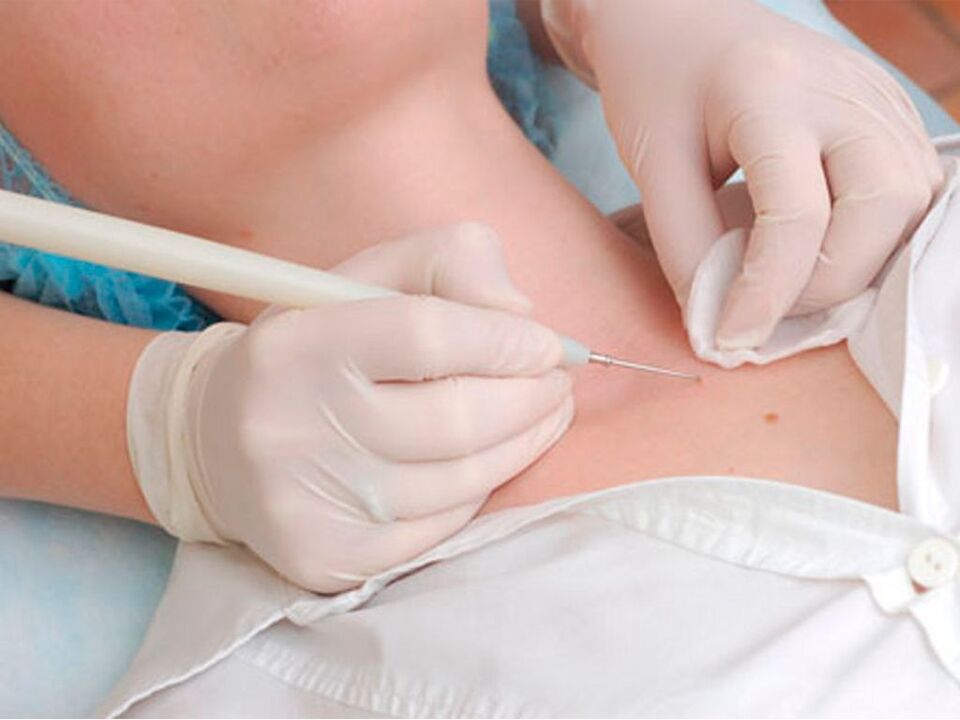
Papillomas are called benign skin and mucous membranes. But certain strains can cause tissue degeneration. Therefore, experts recommend timely removal of papillomas. This prevents the onset of malignancies, including the development of cervical cancer in women.
Papillomatous outgrowths appear on the skin and mucous membranes due to ingestion of human papillomavirus (HPV), which may not manifest for a long time. With weakened immunity, tissue damage, chronic transport leads to cell hyperplasia. HPV begins to multiply actively, causing papillomas or warts to form on the skin or genital warts (the mucous membranes of the genitals).
Predisposing factors
The following factors contribute to the active growth of papillomas:
- frequent exchange of sexual partners, infection with sexually transmitted diseases;
- household contact with people who have warts, warts, or papillomas;
- damage to the skin and mucous membranes;
- weakening of immunity.
In 80% of people who have reached puberty, HPV is present in an inactive form. The virus causes tumors to grow only 6-8 months after contact with the virus carrier. Exceptions are genital warts and papillomas - these appear in the first few weeks after intimate contact with an infected person.
Why remove papillomas?
Papillomavirus poses serious health risks. Strains with high oncogenic risk are particularly dangerous: 16, 18, 30, 31-35, 56-59, 67-68. If papillomatous outgrowths occur, consult a dermatologist or venereologist. The doctor performs an external test and prescribes PCR diagnostics that identify the DNA of the virus and determine the degree of oncogenicity of a particular strain.
In addition, the specialist selects the most effective surgical techniques. Only a doctor who keeps test results handy can tell you exactly how to remove papillomas with minimal health risks. It is not recommended to leave such tumors. Adverse factors can cause inflammation, bleeding, and benign or malignant tissue hyperplasia.
Important!It is imperative to remove papillomas in intimate areas - this is where tumors with a high oncogenic risk are most common.
If papillomatous growths are found on the external genitalia (vulva, perineal region, foreskin), you should consult a venereologist. In addition, it is worthwhile to go through the tests prescribed by your doctor, which aim not only to determine the type of HPV, but also to detect concomitant urogenital infections.

Surgical treatment of papillomas
The main methods of surgical treatment of papillomas are:
- use special local devices to remove papillomas at home;
- cryodestruction (removal of papillomas with liquid nitrogen);
- laser coagulation (laser removal of papillomas);
- removal of radio wave papillomas;
- excision of formations with a scalpel.
Any of the methods listed can remove papillomas. The skilled artisan will assist in selecting the appropriate option, taking into account the location of the neoplasm, the number of papillomatous outgrowths, and diagnostic data. Before removing the papillomas, the doctor must make sure that there is no malignant process. With a high oncogenic risk, experts prefer the classic method of removing papillomas - scalping out neoplasms.
The main indications for the removal of papillomas are:
- the desire to get rid of a cosmetic defect in the form of one or more papillomatous outgrowths on the skin and mucous membranes;
- frequent damage, bleeding, and inflammation of tumors under the armpit, neck, and groin folds, which increases the risk of tissue malignancies;
- detection of moderate to high oncogenic risk papillomas;
- among relatives of malignant cancer patients;
- the location of papillomas is the genitals and internal genitals.
Ideal time to remove papillomas
Before removing the papillomas on the body and face, the doctor warns the patient of possible complications, including the development of age spots. The risk of pigmentation is higher in spring and summer. Many people are interested in whether papillomas can be removed in the summer. If the formations are located in open areas of the body or on the face, it is better to postpone the operation until the cool season, when the likelihood of secondary infection and pigmentation is lower (UV activity decreases in the autumn-winter period).
Important!It is not enough just to remove the neoplasm - so the growth of the papillomavirus cannot be stopped. Surgical methods are necessarily combined with therapeutic methods.
It is impossible to get rid of HPV completely - small amounts of the virus remain in the body. But in combination with antiviral drugs, surgical methods give the highest treatment results.
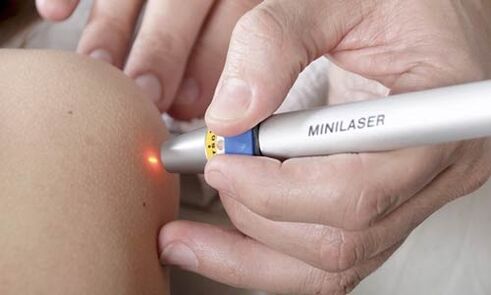
Laser removal of papillomas
Laser removal of papillomas is a modern way to surgically treat HPV. Carbon dioxide laser systems are most commonly used by professionals. After the procedure, scars and blemishes do not remain on the skin. The high cost of laser removal of papillomas is consistent with the efficiency of the method. The final cost depends on the size and number of injuries. At one time, the doctor can perform laser destruction of up to 5-20 medium formations. After the examination and consultation, the specialist will tell you exactly how much it will cost to remove the papillomas and give detailed recommendations. In addition, antiviral treatment is mandatory. Medications are also selected by your doctor.
With the help of a laser, papillomas can be removed from any part of the body, including the genitals. This method is bloodless and does not come into contact. The laser has an anti-inflammatory effect on the tissues, closes the blood vessels and prevents bleeding. Most often, papillomas appear on the hands (warts) and neck - in the form of filamentous outgrowths that are easily damaged during hygienic procedures. Such tumors do not have a high oncogenic risk, but it is still better to get rid of them.
Characteristics of laser removal of papillomas
A dermatologist should be consulted before the procedure. The doctor examines the skin and identifies possible contraindications:
- tissue damage;
- local inflammation of the skin and mucous membranes;
- pregnancy;
- exacerbation of any infectious process;
- herpes.
Laser removal of papillomas uses semiconductor lasers that evaporate viral tumors and at the same time clot the blood vessels. After the papilloma outgrowth, a protective crust (scarring) forms on the skin. One week after removal, it automatically rejects. 2 months after the procedure, the skin tone is completely balanced. The location where the papillomas were will not be different from the adjacent tissues.
Skin care
Scarring after laser removal of the papilloma should be protected from sunlight, water and cosmetics. Violent peeling of the bark is prohibited - this can lead to wound infection, rough scarring and an increase in tissue healing time.
After the scarring has receded, it is recommended to apply sunscreen to the skin before going out. This prevents the formation of age spots. It is not necessary to wear sunscreen during the winter months.

Removal of papillomas with nitrogen
Removal of papillomas with nitrogen involves freezing the neoplasms (cryodestruction). The method is effective for papillomatous outgrowths on the skin. A significant disadvantage of cryodestruction is the inability to regulate the depth of tissue freezing. This is why it is so important to approach responsibly the selection of the clinic where papillomas should be removed. The doctor must be licensed to perform surgical activities.
Ultra-low temperature stops metabolic processes in neoplasm cells, causing their death. A necrotic area is formed at the site of the removed papilloma, which is gradually replaced by healthy tissue. Cryodestruction is available to most patients. The method is much cheaper than other methods (laser coagulation, radio wave removal of neoplasms).
It is possible to remove papillomas both for aesthetic reasons and in the presence of special indications. Of particular concern are neoplasms that grow sharply, change their shadow and shape, become inflamed, and are damaged during hygienic procedures.
Characteristics of cryodestruction
Before removing papillomas with liquid nitrogen, your doctor will thoroughly examine your skin, assess your general health, and identify possible contraindications:
- acute infectious processes;
- decompensated stage of somatic diseases;
- worsening of skin diseases;
- herpes;
- tissue damage at the site of the neoplasm;
- period of pregnancy.
Removal of papillomas with nitrogen was performed without anesthesia. The cryodestructor applicator is held above the neoplasm for 1-2 minutes. The skin becomes white and cold and temporarily loses its sensitivity. During the procedure, a slight tingling sensation occurs and a burning sensation may occur. Within a few hours after the procedure, the skin swells and becomes red, and within 24 hours after cryodestruction, vesicular elements appear in the treated area, which contains whey fluid.
Chrionecrosis of the tissues lasts for up to a month, after which the dead areas of the neoplasm are rejected and invisible spots appear in place, which disappear completely 3-5 months after the use of liquid nitrogen.
Skin care
It is recommended to protect the skin from moisture, sunlight and other harmful factors in the first weeks after cryodestruction removal of papillomas. In case of severe inflammation, consult your doctor. Tissues usually heal on their own, but with a low rate of epithelialization, your doctor may recommend cosmetics that speed up the regeneration of damaged skin.
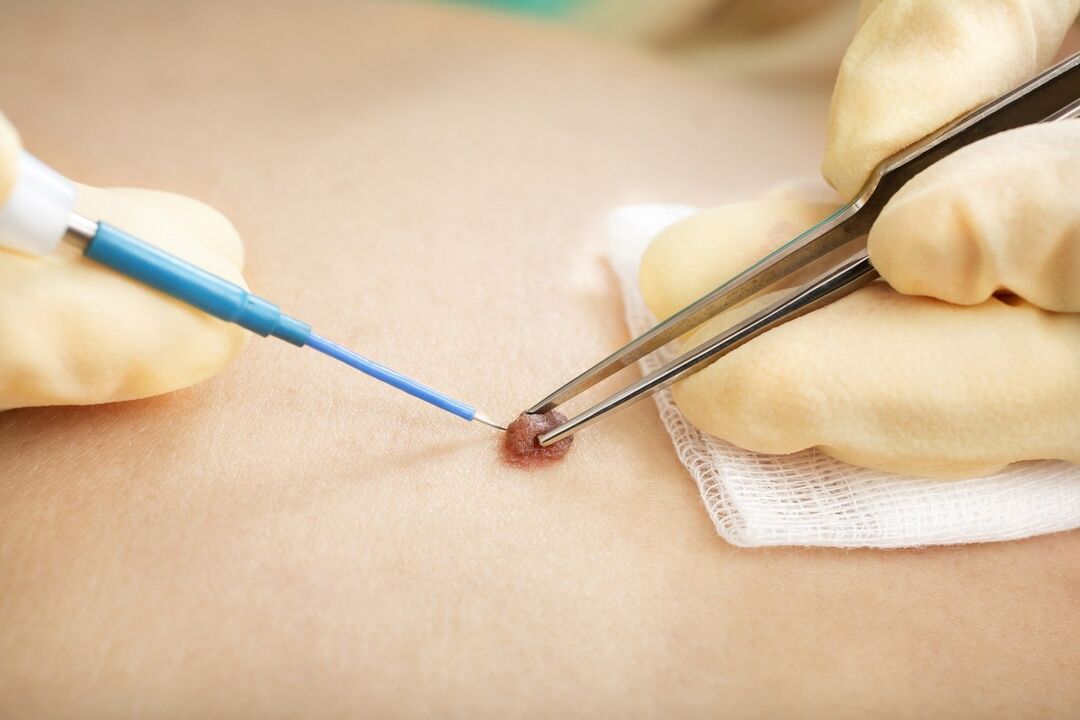
Removal of papillomas by electrocoagulation
Electrocoagulation of papillomas involves the removal of growths on the skin with an electric current. The method is quite traumatic but comes at an affordable cost. High-frequency current coagulates neoplasmic proteins, causing tissue rejection.
Characteristics of the procedure
Prior to electrocoagulation, one skilled in the art may prescribe dermatoscopy, PCR, and other laboratory diagnostic methods. The doctor examines and identifies possible contraindications:
- exacerbation of herpes infection and any inflammatory process;
- pregnancy;
- suspicion of the malignant nature of papillomas;
- hypersensitivity to the skin, allergic reaction to electric current;
- exacerbation of severe somatic diseases, especially in the decompensation phase.
Skin care
Electrocoagulation of papillomas does not require complex skin care. The effects of inflammatory predisposing factors and the addition of secondary infection should be avoided. In the first weeks, the scarring is rejected and then the skin is completely cleansed and replaced with new cells. Exposure to direct sunlight should be avoided during this period. Your doctor may recommend that you treat the wound with a weak solution of potassium permanganate.
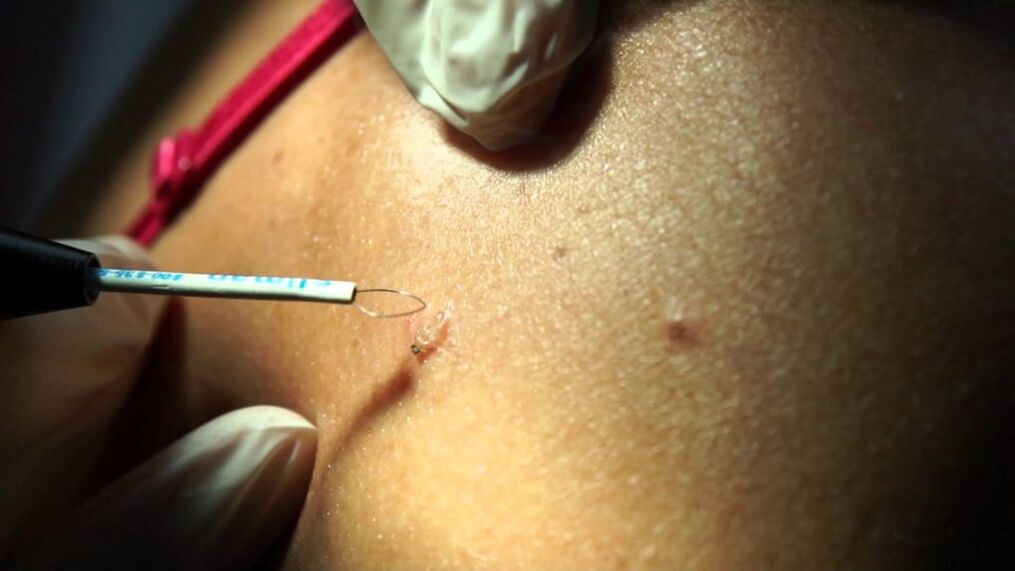
Removal of radio wave papillomas
Removal of papillomas by radio wave method is accompanied by atraumatic incision and coagulation of neoplasmic tissues. Radio waves provide an extremely accurate effect while not damaging healthy tissues or inhibiting the spread of HPV in the bloodstream. Radiosurgical devices used in modern clinics are characterized by their safety and allow the risk of complications to be minimized.
Characteristics of the procedure
Preliminary diagnosis allows the amount of virus in the body to be determined, the type of HPV and the degree of oncogenic risk. When choosing a method of treatment, the doctor takes into account the general state of health and identifies possible contraindications:
- pregnancy, menstruation;
- exacerbation of infectious and inflammatory processes and somatic diseases;
- the presence of malignancies;
- exacerbation of herpes infection;
- skin damage at the site of contact with the radio device.
High-frequency energy cuts the skin, coagulating blood vessels and papilloma tissues. In this case, the electrode does not come into direct contact with the tissues, thus avoiding painful sensations and muscle cramps. In contrast to the method of electrocoagulation, it is possible to reduce the time of thermal exposure and the necrosis of the treated areas by using radio waves.
Skin care
The procedure is performed under local anesthesia. Removal of papillomas takes only 15-30 minutes. Pointed scars remain in place of the treated tissues and are rejected on their own after a week, leaving no rough scars or other defects. During the recovery period, it is recommended to limit exposure to water and ultraviolet rays; do not use cosmetics and household chemicals.
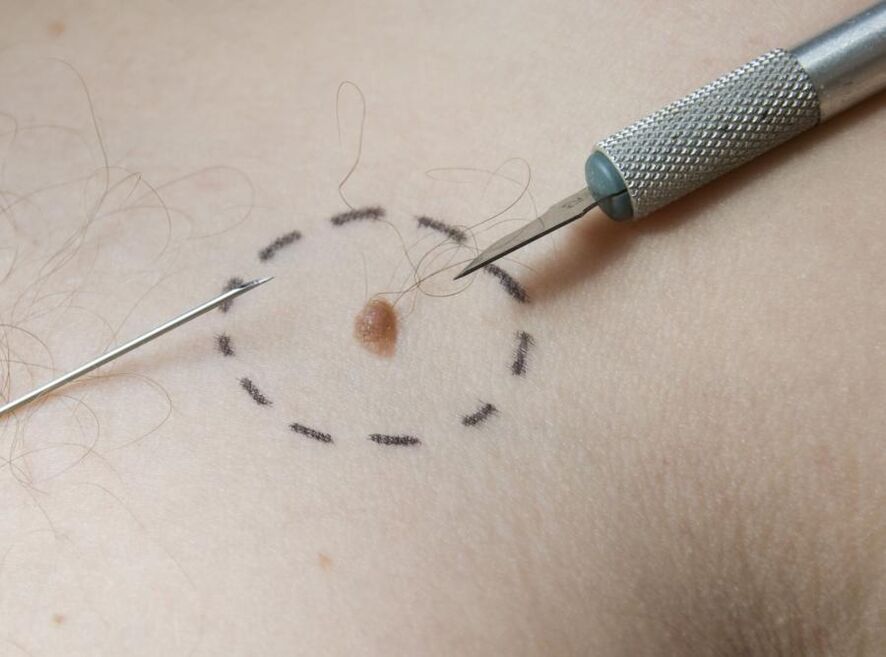
Surgical excision with scalpel
Scalpel removal of papillomas is used quite rarely in classical surgery, especially when malignant signs of the tumor are detected. In this case, the surgeon excises the papillomatous outgrowths by fixing healthy skin.
The method is traumatic, leaving scars and stains. If desired, they can be removed by laser and other cosmetic procedures, including acid exfoliation. Specialists try not to use surgical excision of papillomas in open areas of the body and face.
Devices for removing papillomas
Medicines to remove papillomas and warts work the same way: they contain substances that cause cancer cells to die, and a small scarring will form in the future. It is recommended to use modern types of drugs with a lower risk of complications in the form of secondary infection, acute inflammatory reaction, spots and scars. It is also possible to use cryopreparations which can replace the usual cryodestruction.
Removal of papillomas at home is quite dangerous, especially for large tumors. It is better to contact professionals who will select the optimal treatment options, including antiviral therapy, to prevent future recurrence of human papillomavirus infection. The specialist will tell you exactly how to remove the papillomas at home and whether it is worth doing. Formulations for topical application of skin growths are used for a single small tumor.
As it is not always possible to remove papillomas only with the help of pharmacy products, it is still recommended to consult a dermatologist. For small tumors, your doctor may recommend proven medications that kill the papillomatous outgrowths. In addition, the use of antiviral agents is recommended. An integrated approach increases the efficiency of the entire treatment process. Antiviral agents should only be dispensed with if the papillomas are solitary and not prone to proliferation and malignancy.

Removal of papillomas by folk methods
Removal of papillomas with folk remedies is popular at home. Society does not take papillomavirus seriously enough. Many people don’t even know that papillomas can become malignant. Because it is almost impossible to remove papillomas at home without endangering your health, it is recommended that you see a dermatologist first. Using modern diagnostic methods, the physician will be able to assess the nature of the neoplasm and select an effective treatment regimen.
General methods of home removal of papillomas
You can remove papillomas at home with the following tools:
- celandine juice;
- garlic;
- green walnut juice;
- salicylic acid.
Important!The methods listed destroy skin growths. The use of such funds on mucous membranes is strictly prohibited due to the acute inflammatory reaction and the high risk of chemical burns.
Celandine juice is most commonly used to remove papillomas. The affected areas of the skin are treated with this drug several times a day. In this case, celandine should not be applied to healthy tissues. To prevent burns, it is recommended to treat the affected skin area with vegetable oil or zinc ointment before using the juice.
Prolonged use of garlic has a disinfectant effect and helps to remove warts and papillomas. But this method is not suitable for people with sensitive skin. Garlic often causes inflammatory reactions, a burning sensation and flushing.
Salicylic acid contributes to the destruction of skin outgrowths caused by the active proliferation of papillomavirus. This treatment is often included in finished compositions to get rid of papillomas and warts. Salicylic acid is applied several times a week until the tumor is completely dead.
Green walnut juice strongly stains the skin. The device should be used for a long time to achieve papilloma wilt. The processed fabrics get a dark brown tint, exfoliation and dehydration of the skin are possible.















































































